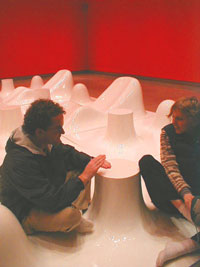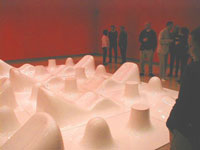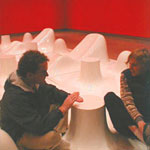Pleasurscape, Karim Rashid’s installation at Rice University Art Gallery, is a grid of glistening white plastic modules on the floor of an intensely orange room. Each module is studded with futuristic bumps that alternately form lounge chairs, TV pedestals and ambiguous mystery humps. Less fun than a moonwalk or a ballroom, the piece nevertheless extends an invitation to play; people crawl and perch uncomfortably among low fiberglass humps and bumps while others watch.
The piece is so sterile and uncomfortable it could be a commentary on the alienating fascism of design. Form dictates function: each unit is a readymade environment for passive acceptance of media input. The chairs are too far apart for talking, the table too far for setting down a drink. It’s a chilling evocation of a cool and alienated high-tech world where everyone aspires to the unreachable detachment of media celebrities.
The piece’s prescriptive rigidity demands subversion. I was seized by a strong desire to do something not allowed. I attempted to sit on a mystery hump and slide down the back of a lounge, but was surpassed in inventiveness by a trio of Rice students who I saw pounding away on a flat-topped pedestal. It made a fair bongo drum.
The design of the ultimate leisure space has been on our collective mind for decades. Compare Rashid’s piece to John Chamberlain‘s Barge, on permanent display in Marfa, TX. Both are room-sized lounging environments, but Chamberlain’s is sexier. Barge is a foam rubber play pit, which puts everyone together in a sexual-revolution era bacchanal. In Rashid’s piece the best we could manage is to send dirty email from one lounging station to another.
We”ve all seen this sort of bubblegum art: colorful biomorphic blobs with vague connections to digital culture, the rave scene, etc. but rarely is it executed with the access to industrial techniques that Rashid can command. Impressively slick, the piece may be too uncomfortable to be good furniture and too shallow to be good art, but dazzles the viewer with lush color and immaculate manufacture.
All images appear courtesy the artists and galleries.
Bill Davenport is an artist and writer and was one of the first contributors to Glasstire.





